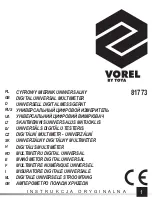
-11-
Diode Tests
The diode forward current I
f
and reverse current I
r
are read LI scale. To check a diode in the forward direc-
tion proceed as follows:
1) Plug the red test lead into the + socket and the black lead into the --COM socket.
2) Select the approximate forward current desired 150
µ
A, 15mA or 150mA and set the range switch to this
position (blue markings in ohms range).
3) Short the test leads together and adjust the
Ω
ADJ pot for a zero reading on the ohms (top) scale.
4) Connect the red test lead to the cathode (striped end) of the diode and the black test lead to the anode
of the diode.
5) Read the forward current on the LI scale. The voltage drop across the diode is shown on the LV scale
immediately below the LI scale.
THEORY OF OPERATION
Introduction
Your multimeter is of professional quality using 1% precision resistors throughout the design. The accura-
cy at full scale reading will be within 3% of full scale DC voltage or current and 5% of full scale AC voltage.
The accuracy of the ohms measurement is 3% of arc.
On the DC volts range, the loading impedance of the meter is 20,000 ohms per volt. This means that if the
range switch is on the 250V position, the loading to the circuit under test will be 20,000 x 250 = 5M
Ω
.
The input loading of the meter is a very important factor to be considered when measuring the voltage of a
high resistance circuit. Take the example where two 1M
Ω
resistors are connected in series across a 9V bat-
tery. The voltage at the junction of the resistors will be 4.5V. When measured on the 10V scale, the input
loading will be about 200K
Ω
(20,000 ohms/volt times 10V). The voltage at the junction will therefore drop
to 1.28V and the meter will read this voltage. If the meter is switched to the 50V position, the loading will
be 1M
Ω
and the meter will read 3V. For reasonably accurate measurement, the circuit under test should
have an impedance of less than 100K
Ω
or you should use the higher ranges. The loading on the 250V and
1000V ranges wil be 5M
Ω
and 20M
Ω
respectively, but it will be hard to read 4.5V on these ranges.
DC Voltage Measurement
Figure 9 shows a simplified diagram of the DC voltage measuring circuit. Here resistors are switched in
series with the meter to provide the desired ranges.
AC Voltage Measurement
Figure 10 shows a simplified diagram of the AC voltage measuring circuit. Two diodes are added to the
series resistors to rectify the AC voltage. The input impedance on the AC voltage ranges is 9K
Ω
per volt.
On the 250VAC range, the input impedance is therefore 2M
Ω
.
Figure 9
Figure 10
R9
3K
R3
5K
R4
40K
R5
150K
R6
800K
R7
4M
R8
15M
1000
250
50
10
2.5
0.5
0.1
FUSE
-COM
R13
83.3K
R14
360K
R15
1.8M
R16
6.75M
1000
250
50
10
FUSE
--COM
Summary of Contents for M-1150K
Page 15: ...SCHEMATIC DIAGRAM 14...


































